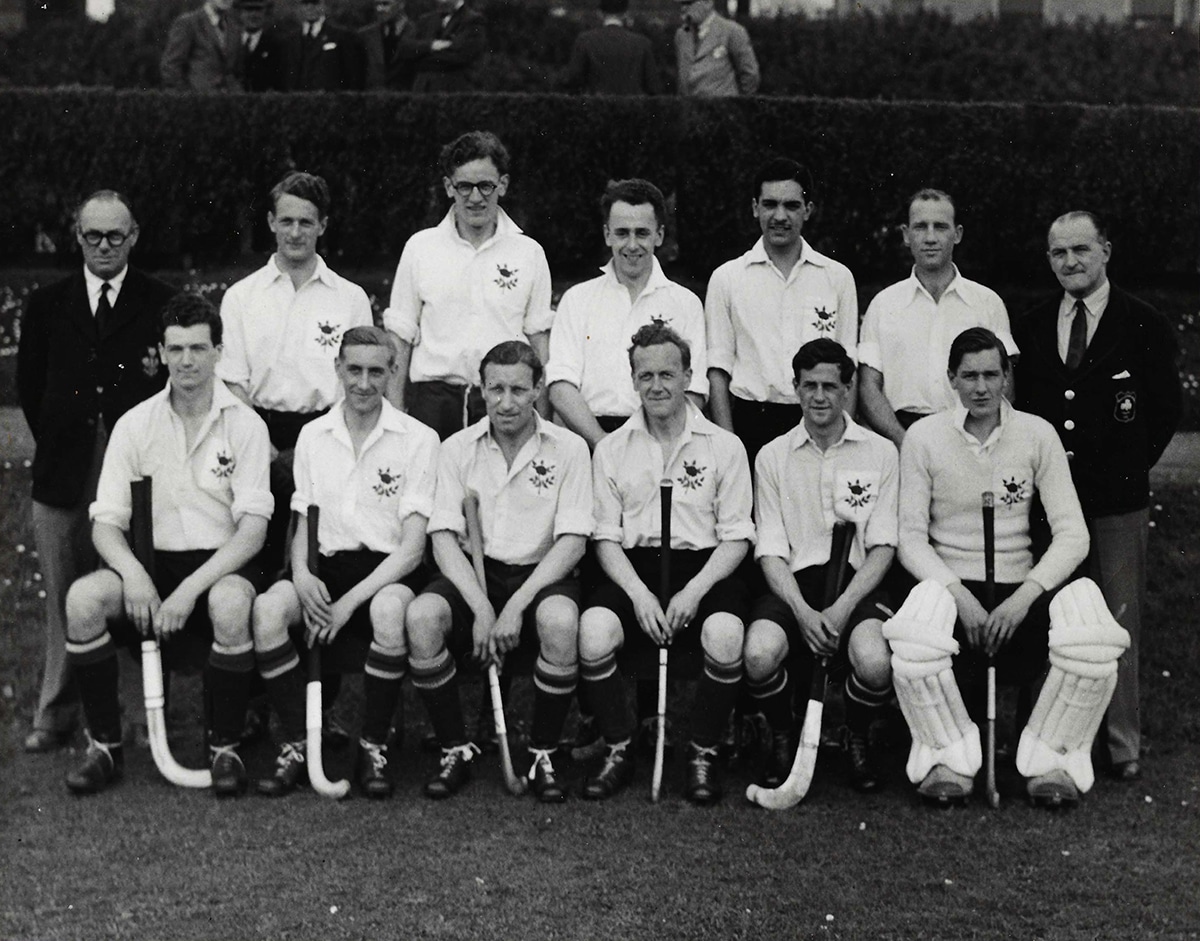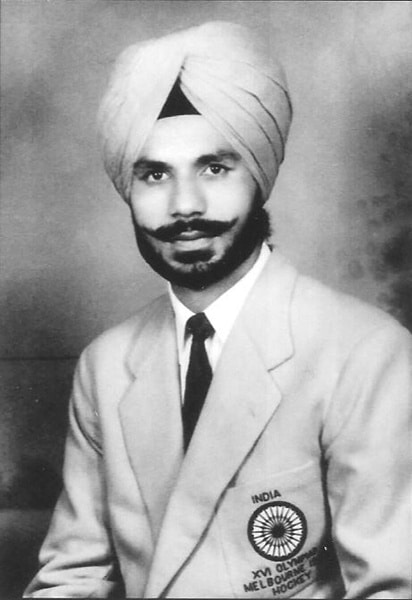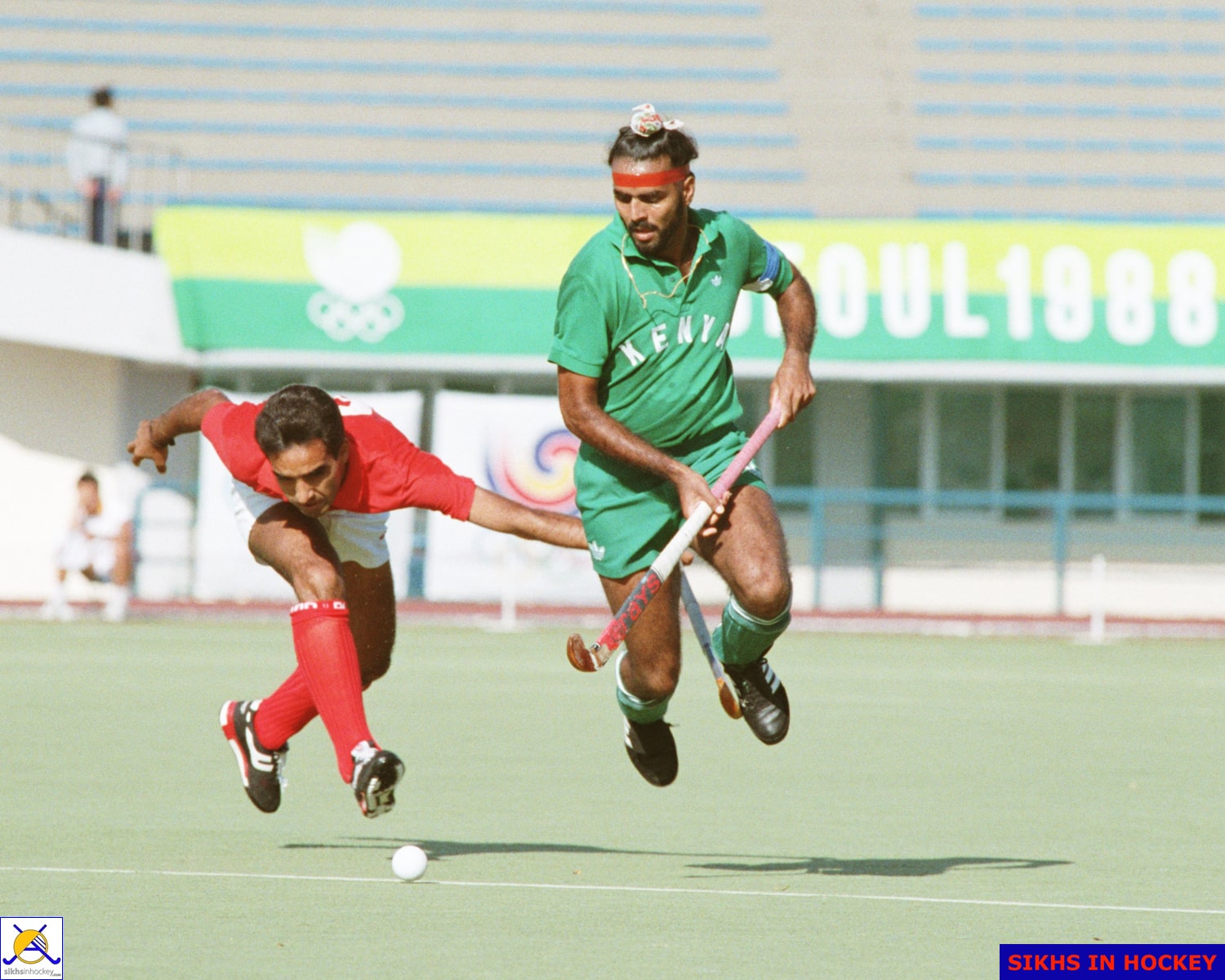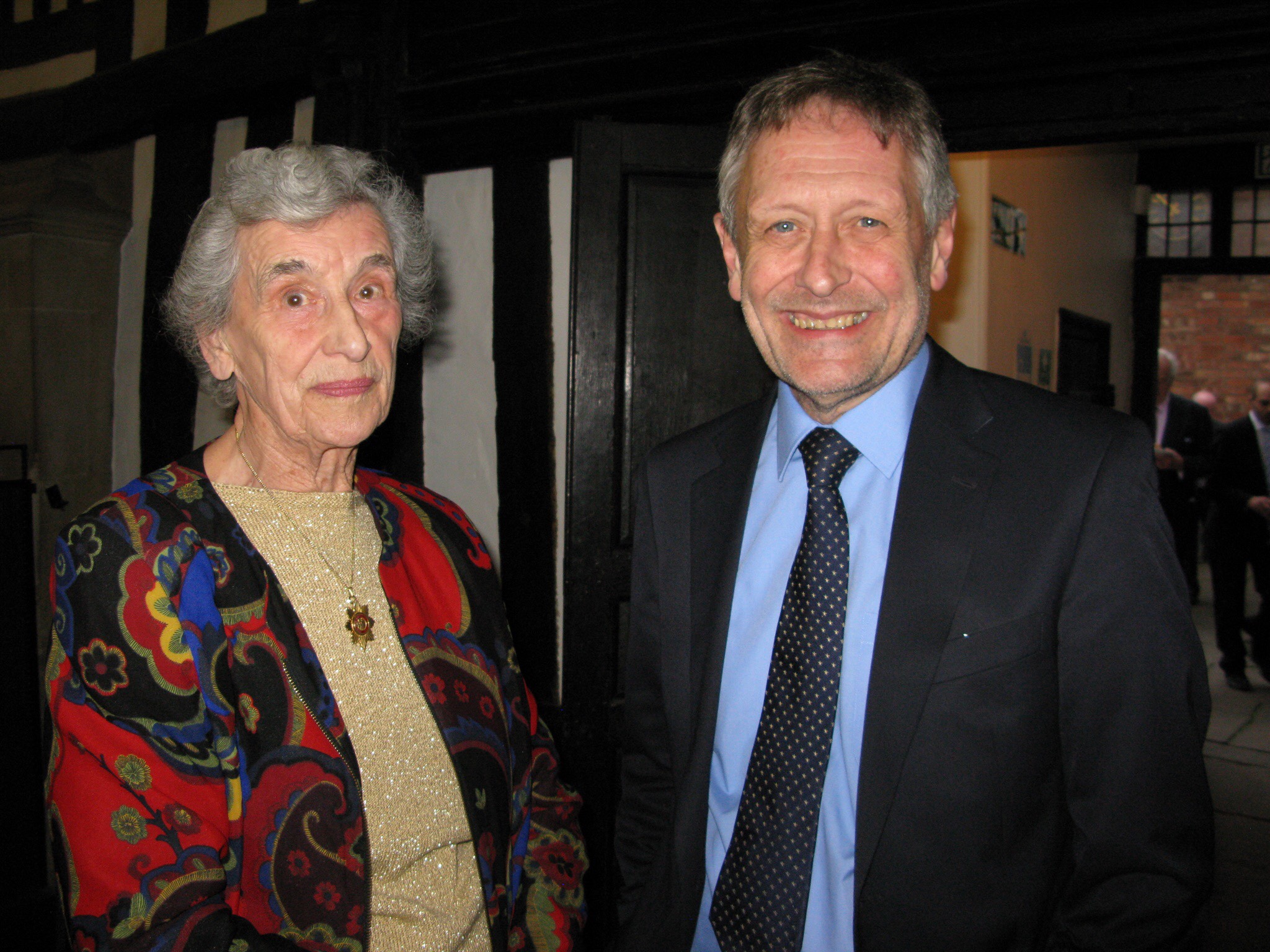16.03.1936 – 10.01.2025
Few sportsmen and women represent their country in more than one sport. Even fewer in more than two. Thelma Hopkins was one who did, making her debut when just sixteen years old in two distinct sports. She played hockey for Ireland and represented Great Britain and Northern Ireland in athletics, participating in successive Olympic Games, winning a silver medal. She also played squash for Ireland.
Increasingly, professional sportspeople have to concentrate exclusively on their sport. Traditional seasons for sport have become less defined, narrowing the chances of participation at the top level in more than one sport. There is a tendency to forget how talented sports people of previous generations were in playing different sports at international level.
Thelma played 40 times for Ireland as a regular goalscoring forward and became known for her mastery of the reverse-stick pass – a technique that was rare in the women’s game at the time. However, she was probably better known as an athlete, specialising in the long jump and high jump. She was also adept over hurdles at 80 metres and, at club and representative level, throwing the javelin and the discus. Perhaps unsurprisingly this led her to the pentathlon. Being from Belfast, she was an inspiration to and competed against Mary Peters, who was three years Thelma’s junior. Mary would go on to win an Olympic gold medal in the pentathlon in 1972.
Mary Peters (athlete) – Wikipedia
Thelma came to prominence in athletics with her selection for Great Britain in the 1952 Olympic Games in Helsinki, in which she placed fourth in the high jump with a jump of 5ft 2½ins. She won gold medals in the European Championships and what was the Empire and Commonwealth Games. She was for a time the holder of the world record in the high jump. She was known for her consistency in international meetings and reliability in winning points for the women’s team against accomplished European opponents. Then in 1965, she played hockey for Great Britain & Ireland on a tour of the United States, now recognised as the first women’s Great Britain hockey side to be formed.
She was first selected internationally when she was studying at Victoria College and then at Queen’s University, Belfast, aiming initially to be a dentist. She later found it too difficult to combine study for exams with training and competition (particularly when it required international travel) and withdrew from her course. She later took up social science at Queen’s but graduated from the University of Ulster at Jordanstown (formerly the site of the Ulster College of Physical Education) to become a PE teacher. Thelma rarely took a break from sport and at the end of the athletics season would straightaway be seen on the hockey pitch for Victorians (the club connected with her school) and then Queen’s University or for Ulster. This virtually seamless swap recurred at the end of the hockey season.
Family life and emerging talent
Thelma Elizabeth Hopkins was born in Hull on 16 March 1936 to sporting parents. Her mother, Mildred, had played hockey for Yorkshire and her father was a noted local cricketer, playing for Pembroke Cricket Club from Sandymount, Dublin. He also played hockey for Cliftonville and rugby for Enniscorthy in County Wexford. Later, Mildred was appointed an international hockey selector for Ireland. Notwithstanding these circumstances, Thelma always regarded herself as “an Ulster girl”.
Thelma’s elder sister, Moira was also a talented athlete and hockey player. The two sisters regularly competed alongside one another in both sports. For example, at the Ireland Women’s Amateur Athletic Association (AAA) event at Ravenhill in June 1952, Thelma won the high jump at 5ft 1in. She won the javelin event and was third in the discus. Moira, then seventeen, won the discus and was second in the high jump and the shot. When Queen’s University retained hockey’s Chilean Cup on 11 February 1955, with a 6-0 defeat of University College, Dublin, Moira scored a hat-trick and Thelma two of the other goals.
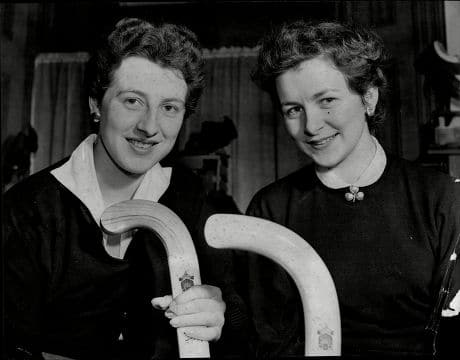
The hockey-playing Hopkins sisters, Thelma (left) and Moira (right).
Photograph courtesy of Hockey Ireland.
Thelma showed early prowess in jumping over a clothes line in the back garden and then a bamboo pole stretched between two cones. Her father built a sandpit at home and added a high jump area. He installed an electricity cable from the house to the garden to provide lighting so that she could continue to train in winter darkness. Seeing her potential, Mildred took Thelma at the age of twelve to see Franz Stampfl, an Austrian, who was coaching athletics at Queen’s University. In athletics, coaching was not then universally recognised and treated by some with disdain or even suspicion. He was eccentric, known for his tough training regimes and for an imposing aura, bordering on the brusque.
He adopted a scientific approach and with constant speed timing and pulse taking, devised a training method of interval running over a set distance, in which each distance would be done at a faster speed than the previous (and the recovery period in between would become progressively shorter). He started training athletes as a freelancer, charging a shilling per head per day. On returning to Britain after internment in Australia, he began coaching Christopher Brasher (who went on to win the 3,000m steeplechase at the 1956 Melbourne Olympics) and who introduced him as coach to Chris Chataway and Roger Bannister. On 6 May 1956 at Iffley Road, Oxford, with Stampfl alongside the track and Brasher and Chataway pacing him, Bannister famously broke the mile record at under four minutes.
Stampfl agreed to take Thelma on. He grew confident that Thelma would become the first woman to jump more than six feet high and go on to win Olympic gold medals in the high and long jump competitions. He was handily based in Northern Ireland at the time and Thelma was able to accommodate his training regime. When Stampfl moved back to Australia, he sent tape recordings to Thelma containing his coaching advice.
In June 1951, Thelma won senior athletics titles in Northern Ireland in the high jump and long jump. In the former at the RUC Games at Ravenhill, she cleared 5ft ½in, a new record, as was her long jump leap to 18ft 8½ins in the Northern Ireland Women’s AAA championships (in which she also won the high jump). It led to her being listed by the British Amateur Athletics Board in September 1951 as a possible participant in the forthcoming Olympic Games. Following her third place in the Women’s AAA championships in June 1952, she was selected for Helsinki, while still sixteen years old.
In an interview with the Belfast Telegraph on 3 October 1953, Thelma admitted that although she had come into the public eye through her jumping, she really preferred playing hockey:
It’s thrill when you clear a height but I like the team spirit of hockey. I would rather do things with other people than be out on my own.
Hockey
When aged 13, Thelma was chosen to play in the final Ulster schools’ trials, alongside her sister. Ulster went to win the schools’ inter-provincial championship a month later. Ireland’s Saturday Night commented that “the babies of the team, Moira and Thelma Hopkins … did not appear at all overawed by the occasion and proved that they have ‘big match temperament’ …”
One year later, Thelma was identified by the same newspaper as the best player on the field in the final schools’ trial on 17 February 1951. Her “stickwork and placing of passes would have done credit to a player of much greater experience.” It described her as “outstanding” in Ulster’s 4-1 win against Leinster on 10 March 1951. She also opened the scoring for Victoria College in the final of Ulster Schools Cup, which ended in a 2-2 draw. By April 1951, Ulster Schools had retained the schools’ inter-provincial championships, scoring 21 goals, of which Thelma had contributed eleven and her sister four.
Thelma was selected for the Ulster senior team to play a Manchester Women’s Hockey League Eleven at Bladon Drive, Belfast on 13 October 1951, which they won 4-0. The Northern Whig said of Thelma that “in her first senior representative game [she] was certainly very competent.” It asked “Why single her out for special mention? Well, she’s only 15. She has been playing for Ulster schools since she was 12 years of age.” Three perfectly placed passes from Thelma allowed Daphne Ferguson to score and “it was a pleasant change for the Ulster forwards to be the better part of the team.”
Miss Thelma Hopkins showed herself to be player of great promise, although if positioned at inside-right, which is not her normal position, she will have to distribute the ball little more to her wing player and, as an inside-forward, she should also do more foraging downfield.
— Belfast News-Letter, 15 October 1951
She continued her hockey and on Boxing Day 1951 played for an Ulster Eleven against The Rest in anticipation of the first Senior Inter-Provincial Championship game against Munster in Dublin. Ireland’s Saturday Night reckoned that the Ulster forward line was its best scoring machine “for years, particularly the inside trio”, which included Thelma. She retained her place for the Munster game that Ulster won convincingly and for the final match in the Championship against Leinster.
In the 1952-53 season, both Thelma and Moira were chosen by Ulster to play Munster. On 17 January 1953, before a record crowd for a women’s inter-provincial match, Ulster defeated Leinster 3-0 “for the first time for many years”. Playing at centre forward, Thelma scored the opening goal and, mid-way through the second half, converted a cross from the left wing provided by Moira. Thelma then laid on the third goal for Daphne Ferguson to score five minutes from the end.
After the final trial in Dublin on 7 February 1953, Thelma was selected, alongside Moira, to play for Ireland against Wales at Penarth on 28 February 1953. Ireland’s Saturday Night added:
One of the quickest centre forwards in the country, Thelma will give life to the Irish five and, if given the support, will get the goals at Penarth and … again at Bladon Drive when Ireland meets Scotland on 7 March 1953.
Ireland won 2-0, with goals from Thelma in the first half and her sister in the second. Ireland then had a hard-fought 2-1 win against Scotland, both goals being scored in the final five minutes by Thelma (to give Ireland a nineteenth win in these games). England then beat Ireland 5-2 in Cheltenham. Thelma scored when England had a three goal lead.
Thelma took part for Ireland in the International Federation of Women’s Hockey Associations’ (IFWHA) tournament at Folkestone at the start of the 1953-54 season. Ireland beat Holland 4-1, Denmark 6-0, New Zealand 2-1, Switzerland 5-0, Germany 3-2 and, lastly, India 7-0, leaving Ireland as the only undefeated team. However, it was noted that Ireland had not played Australia, South Africa or England (and, therefore, according to The Times, “no comparison can be drawn”).
In December 1954 she was voted ‘Sportsman of the Year’ [sic] by the Belfast Telegraph. In April 1955, Thelma was “Ireland’s match winner” in a “dazzling display” against Scotland, which Ireland won 3-1.
Thelma remained committed to hockey despite athletics preparations for the 1956 Olympic Games in Melbourne.
In 1957, she was selected for Ireland against England at Wembley, for her eleventh cap. England won 2-0 before a record crowd of 48,000. Her play was said to have ruffled England. One of her shots hit the post and another was inches wide. She then slipped as she was about to shoot, with only the goalkeeper to beat.
That same year, Thelma helped Queen’s University to win the Senior League championship for the second year in succession. Next season, she played for Queen’s, who beat Victorians 3-0 at Ormeau on 12 October 1957. It was the first women’s senior hockey match to be played in a Belfast public park and, as such, was a milestone in the history of women’s hockey in Northern Ireland.
A month later, the Queen’s University forwards were again rampant defeating Owls 8-2 in a league match, with all the Queen’s goals scored by the Hopkins sisters; Thelma with six and Moira with two.
In 1958, the Ulster and Irish selectors insisted that Thelma’s best position was centre forward, which she disliked. The Northern Whig commented that Thelma liked room to move, to make her own chances and was most dangerous in breakaways when least expected, thriving on wingers who forgot to mark; whereas at centre forward, she was bottled up and her striking power and value to the team was halved. It asked what the sense was in playing her in a position where heart was not in the game. It expected that the Irish selectors would learn the hard lesson, as Ulster had done.
In October 1962, Thelma withdrew from the Empire Games, citing insufficient preparation and an inability to do justice to her selection but was asked to reconsider. She continued with hockey, captaining Ulster to a 4-2 over Cheshire. She was now back playing club hockey for Victorians, noted as having scored two thirds of their goals in early season matches. She relented and agreed to take part in the Games in Perth. Her suspicions were fulfilled when she could only manage eighth place in the high jump.
Against Holland on 30 March 1963, Thelma was selected as left wing. She scored from a penalty corner in a 1-2 defeat to Scotland in Belfast on 6 April 1962 that left Ireland jointly in last place in the international table. At club level, Thelma helped Victorians to retain the Senior League, with a hat-trick against Mid-Antrim on 27 April 1963. It closely coincided with her decision to confine herself to club-level athletics only. She suggested that golf had now captured her imagination. She said that her latest decision was not the end of her athletics career “but only the beginning of a new phase.”
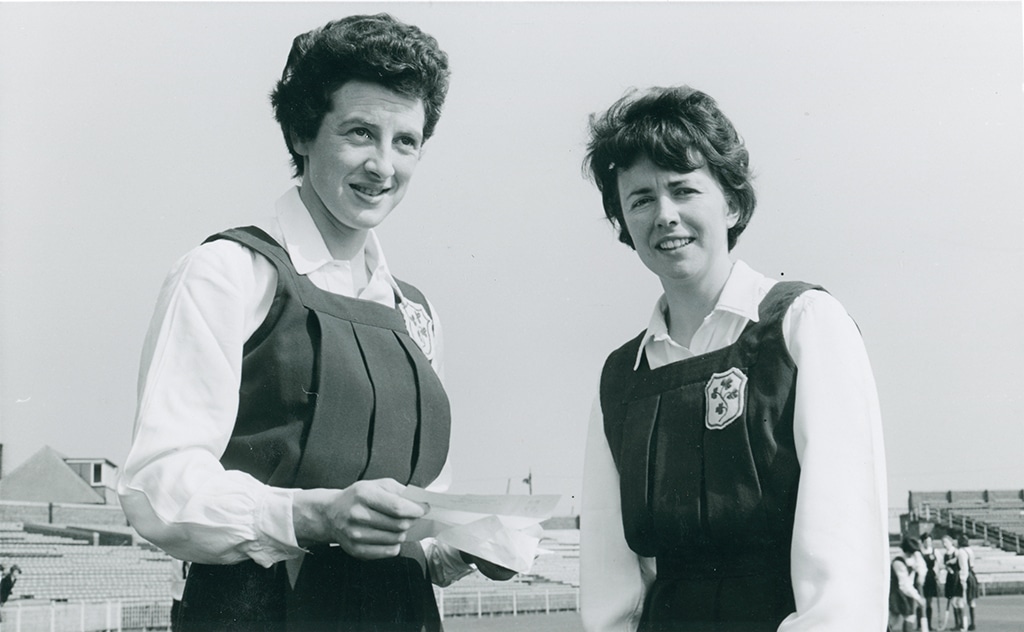
Thelma Hopkins of Victorians Hockey Club (left) and Helen O’Neill of Pembroke Wanderers Hockey Club (right) representing Ireland against South Africa in Belfast, March 1965. Ireland won 2-1. Thelma would play only two more international matches for Ireland.
Photograph courtesy of the Irish Hockey Archive.
Athletics
Thelma’s athletics prowess was brought to national prominence with her selection for the Olympic Games in 1952. She was then selected for Great Britain against France in Paris in August. She won the high jump competition with 5ft 1in, beating Sheila Lerwill, the British champion, for the first time. She tied for first place in the high jump at 5ft 4½ins with Dorothy Tyler against Italy in Naples.
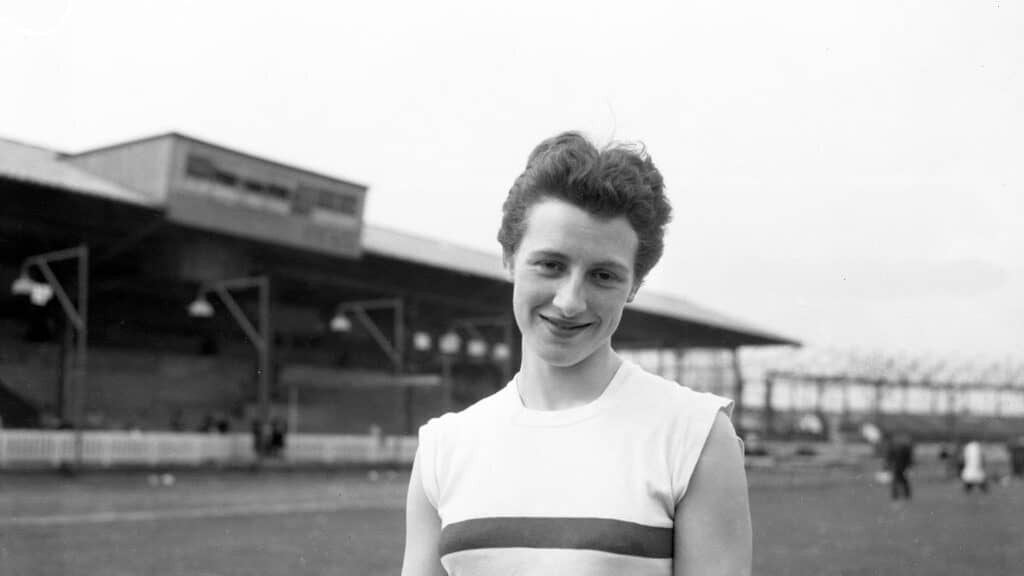
Thelma Hopkins at an athletics event.
Photograph courtesy of Hockey Ireland.
In June 1954, Thelma was selected for Northern Ireland in the British Empire and Commonwealth Games in Vancouver, competing in the high jump, long jump, 80-metres hurdles and the javelin – “one of the busiest competitors in the Empire Games.” In a surprise result, she won the high jump with 5ft 6ins (a new Games record) beating Dorothy Tyler and just failed at 5ft 8ins, the world record height. She finished second in the long jump by 9½ins to Yvette Williams of New Zealand (who became the first Empire Games triple gold medal winner). Thelma was fourth in her heat of the 80m hurdles, with a time of 11.4 seconds, where only the first three in each heat qualified for the final.
She confessed to having been “swept off her feet” by the enthusiasm shown after her success in the high jump.
I felt like a Hollywood star for minutes, as reporters and photographers swarmed around me and officials rushed up to congratulate me. It was a wonderful thrill. I wouldn’t have missed it for worlds. I never imagined there were so many people in the world with Irish grandmothers. Even in the street, in buses and trams, complete strangers came up to shake hands and talk about back home in Ireland.
A fortnight later she travelled to the European Championships in Bern. She won the gold medal in the high jump, achieving 5ft 5¾ins. It was a tense competition against Iolanda Balaș of Romania. On the latter’s third attempt, Thelma sat on the grass and buried her face in a blanket. When Iolanda failed to clear, Thlema said, “It is wonderful. I can scarcely believe it. This is more than I dreamed of.” It was a record height for the European Championships.
Thelma carried on in international meetings against Hungary in October 1954, coming second to Dorothy Tyler for Great Britain, where in pouring rain, officials poured petrol on parts of the track and set fire to it shortly before racing began, in an attempt to dry it. She was then second to Tyler in the tie against Czechoslovakia. The competition nearly did not take place, when it was discovered at Sturova on the Czech frontier that a visa for Thelma to enter the country had not come through and the Secretary to the British AA Board threatened to withdraw the whole team.
In June 1955, the Northern Ireland women’s AAA championships were held in conjunction with the men’s events. Thelma stole the limelight by taking five titles. In the 80 metres hurdles she clocked 12 seconds to equal the all-comers’ record. In the shot she had a put of 33ft 9½ins, which was 8½ins beyond the all-comers’ record (but it did not constitute a new record, as the shot was found to be slightly under weight). She retained her three titles in the high jump (5ft 2ins), long jump (I8ft 2ins) and the javelin (101ft 9ins).
Later that season, she appeared for Great Britain against Germany at White City. Millions of gallons of water were spread on the dry track. Thelma won the long jump and the high jump at 5ft 6½ins. She once more tried at 5ft 8ins but brushed the bar with her trailing leg. Though she had been selected for Great Britain in the International University Games in San Sebastian, Spain, she was instead required to compete for Great Britain against Hungary. She won the high jump with 5ft 7ins in the final event, having taken the long jump with 18ft 7ins. She was praised for her consistency. In September 1955, she was rested against France at Bordeaux, to avoid over-competition but joined the strongest ever team of 66, plus officials, to face Russia in the Dynamo Stadium, Moscow.
There, Thelma won the high jump with 5ft 7ins and made three unsuccessful attempts at the world record height. She was third in the long jump with 19ft 6ins (in which the world record was broken by Nina Vinogradova). The crowd numbered 60,000 and the British team was generally “outclassed by superbly fit Russians.” 50,000 attended the Army Stadium in Prague two days later, when Great Britain met Czechoslovakia. Thelma won the high jump at 5ft 7½ins (her best of the year so far) and the long jump with 19ft 10½ins. She described the trip as an experience not to be missed.
In August 1956, Great Britain reciprocated hospitality at White City. Three months earlier in May 1956, Thelma had jumped a world record height of 1.74m (5ft 8½ins) at Cherryvale Park in Belfast. In doing so, she had become the first person to break a world record in Ireland. It was, however, short-lived; Balaș jumped 1.75m (5ft 8¾ins) for the world record height in Bucharest in July. Against Czechoslovakia, Thelma won the high jump with 5ft 5ins, was second in the long jump and third in the 80m hurdles. The meeting witnessed a Russian protest when their discus thrower, Nina Ponomareva, was charged with shoplifting five hats in Oxford Street (for which she was later discharged absolutely). Russia withdrew its team but there was no flight home and they remained in their hotel in the morning. In view of the impending Olympic Games, they were invited to train at the Hurlingham Club, along with most of Great Britain’s athletes (including Thelma) to show that there were no hard feelings. The British Athletics Board later required all Great Britain’s selected athletes to compete against Hungary for similar emphasis, which led the Belfast Telegraph to comment that “the life of an international athlete is not all milk and honey.”
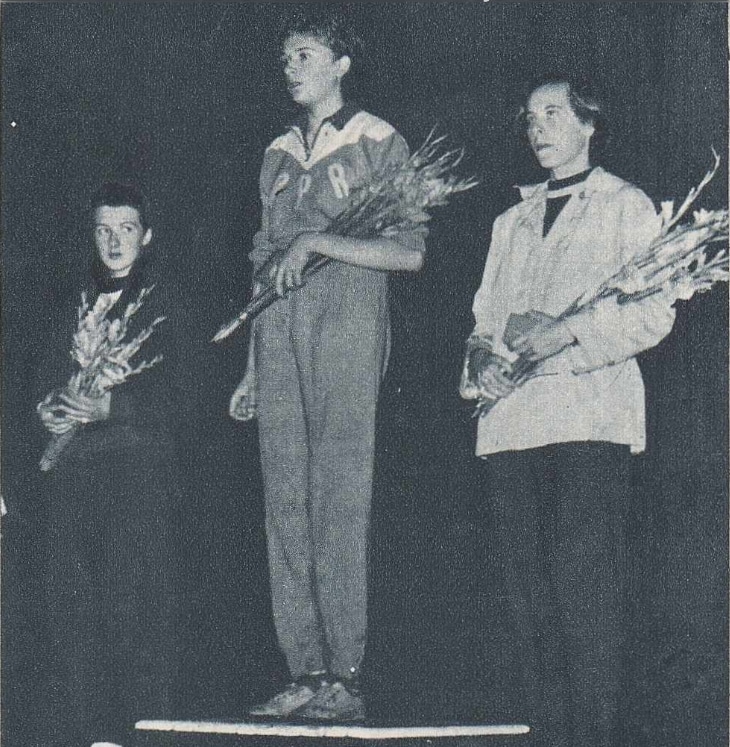
Thelma Hopkins, Iolanda Balaș and Olga_Modrachová, 1955.
Public domain.
Iolanda Balas: The ‘smile’ of Romanian athletics history | News | Heritage | World Athletics
Thelma was picked for Great Britain for the Melbourne Olympic Games. They were staged at the end of the season for Britons. Her coach Franz Stampfl was confident that Thelma would win a gold medal in both jumping events, particularly after her performance in Helsinki four years earlier. However, she did not qualify for the final stage of the long jump, unable to reach the standard of 18ft 8¼ins. This was widely reported as a minor sensation. She dismissed suggestions that her strapped right ankle had adversely affected her performance. On the last day of the Games, she was beaten in the final of the high jump to take the silver medal with a jump of 5ft 5¾ins. Thelma needed injections for stomach and leg injuries. She had lost 6 pounds in weight in two days and was not at her best. “I’ve been unwell for some time,” she told The People. “I’ve had to have lots of injections this past week and they made me feel really groggy. At one time it was touch and go.”
Thelma continued with international athletics in 1957. She faced competition in this country from Mary Bignal of Wells, who was at Millfield School on an athletics scholarship. As Mary Rand, she went on to win the Olympic title in the long jump at the 1964 Games, breaking the world record. Mary was an all-rounder in a similar manner to Thelma and the two contested the jumping events as well as the pentathlon, in which Thelma had set a British record in July 1955 that was only ratified in October 1957. Mary broke this record in August 1959 (before going on to win an Olympic silver medal in the event in Tokyo in 1964).
In July 1958, Thelma defended her Empire and Commonwealth Games title in the high jump in Cardiff. She also took part in the 4x110m relay and the long jump (in which she finished seventh). She had gone through a lean period up to the Games and in the high jump failed to clear 5ft 3ins and reach the last six. It was a shock elimination. Candidly, she said that she simply was not the jumper she was. All the competitors in the high jump complained about interruptions, especially with intervening award ceremonies. They were left standing in the cold, huddled in blankets. It was her poorest performance in international competition. She took two attempts to clear 5ft 2ins and, reportedly, never looked like clearing 5ft 3ins. Afterwards, she set out for British Guiana (now Guyana) as volunteer athletics coach for a few weeks.
She returned to athletics in the summer of 1960. In May, she cleared 5ft 4ins that put her as a possible selection for the Olympic Games in Rome. In July, in her first appearance at Santry, north of Dublin, she jumped higher than she had for several seasons at 5ft 5ins, only ¾in below the Olympic qualifying standard. She claimed not to have serious aspirations about competing in Rome but “had she exceeded 5ft 6ins, her name would have come into consideration”. She went on to the City of Edinburgh Highland Games in August 1960 and won with a height of 5ft 5½ins. However, she was not selected for the Olympic Games. She was described as the unluckiest girl athlete in Britain, being the most likely to have challenged Balaș for the gold medal. The general view in the British camp was that the winning effort of Edinburgh came ten days too late. Another commented that “the dropping of Thelma Hopkins from this year’s Olympic team looks like being a serious error on the part of the much-criticised selection committee”.
In 1961, she returned to competition, clearing 5ft 6ins at the Londonderry Trophy meeting in May and, with 4,379 points, winning the pentathlon in Bruges with Great Britain against Belgium and the Netherlands. She won the double for Great Britain against France in the high jump (5ft 7½ins) and long jump (19ft 2¼ins) in June. She then won a bronze medal in the World University Games (later the biennial Universiade) in Sofia, with 1.65m.
Squash
Thelma’s participation in front line squash was first noted in January 1961, when she was selected for Ulster against Leinster in Dublin, winning 5-0. It was expected that she would win a place on the Irish side that year, “as she is very fit, and would beat most of the men playing in the “B” league without bother”. Ulster clinched the inter-provincial tournament in 1963 when they defeated Leinster, winning the final three games. Thelma was said to have little difficulty beating the top string in straight games, though the team’s win was only by a margin of 3-2.\
There was a significant rise in the popularity of women’s squash in Northern Ireland. In 1964, there were 32 entrants for the women’s Irish Open Championship and a year later there were 80. Thelma won the championship on 6 February 1965, applying her speed stamina and hard hitting to win 6-9, 9-7, 9-2, 9-3. She had earlier that day played in the Irish hockey trial in Dublin!
United States hockey tour
Thelma was one of 16 women who toured the United States in 1965 as the Great Britain & Ireland Touring Team, now recognised as the first Great Britain women’s hockey team. She is Great Britain women’s player number 11. Her mother was a late replacement as manager-umpire. The team played sixteen matches, including two latterly accredited as full internationals against teams selected by the United States Field Hockey Association (USFHA).
The tour began in early October 1965 and lasted just short of a month. The first match was against Long Island, which the tourists won 11-0, with Thelma scoring three goals. Great Britain went on to score 16 goals in four matches before defeating the United States team 5-1 on 9 October 1965, as well as a 4-1 win against a US reserve team at Kent Place School in Summit, New Jersey. In a subsequent 9-0 win in Boston, Thelma scored eight of the goals.
In the main, matches were played on rough grass school pitches that tended to be smaller than those to which the Great Britain players were accustomed and called for constant adaptation. The second full international match took place at Smith College at Northampton, Massachusetts on 26 October 1965. This is reported to have ended in a 4-4 draw. A sixteenth successive victory was achieved in a 7-0 defeat of Delaware, in which Thelma scored four goals. The only loss on tour occurred in the eighteenth match, a 1-2 defeat to Brandywine, in Western, Pennsylvania. In all its matches the team scored 121 goals and conceded five (or six, dependent upon the accuracy of the reporting).
The Story Of The First GB Women’s Matches: Born In The USA – The Hockey Museum

Back row: Jennie Braham (England); Joan Horne (Ireland); Maureen Short (E); Helen Weir (Scotland); Bridget Cannel (E); Thelma Hopkins (I); Valerie Sinclair (S).
Sitting: Mary Hyland (Wales); Janice Mitchell (S); Joyce Hunter (S); Mrs Hopkins, Manager (I); Nan Thomas (W); Ellen Toulson (E); Helen O’Neil (I).
Kneeling: Barbara Stacey (W); Janet Morgan (W).
After Christmas and the team’s return, before the game between Ulster and Ulster Reserves in Belfast, it was disclosed that Thelma had married Ian McLernon, an Ulsterman, in a very quiet ceremony in Washington DC. The couple were thought to have finalised their plans when able to meet while the hockey tour was taking place. Thelma said she still hoped to complete her course at Ulster College of Further Education and suggested that they might then move to New Zealand. She dropped out of athletics after her marriage.
Her husband was an accomplished oarsman, who first rowed for Methody (Methodist College, Belfast) and graduated from Queen’s University with a civil engineering degree. He rowed at four in their first eight in the 1963-64 season and again in the following year, including appearances in both years, among others, at the Henley Royal Regatta.
After the birth of their first child, Joanne, the McLernons emigrated to Edmonton, Alberta in Canada. Thelma returned to Ulster occasionally. In 1969, she formed a field hockey team in Edmonton in the hope it would catch on but the long winter with four to five months’ cover of snow made it difficult to play hockey outside..
In 1976, Thelma returned to Dublin to receive a Texaco Hall of Fame award. Interviewed at Glasgow Airport, she revealed that volleyball, basketball and skating were now in favour. She was still playing squash and coaching gymnastics.
Thelma spent the next decades teaching sports to children, running a day care centre and providing housing for international students. Her husband died on 3 December 2020 aged 78. He took trips in the latter years to the United States and Tijuana, Mexico for treatment for a cancer which he bore with fortitude for the last eight years of his life.
Thelma was also known for her love of animals and as a supporter of the World Wildlife Fund and the local Society for the Prevention of Cruelty to Animals. She died on 10 January 2025, survived by her daughters Joanne and Lynn and her son Tony, as well as two grandchildren, Dylan and Lauren.

